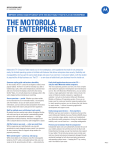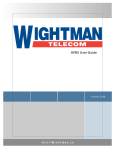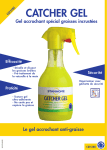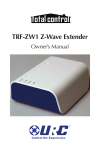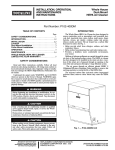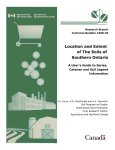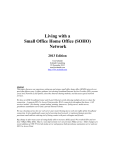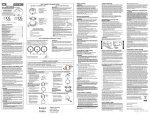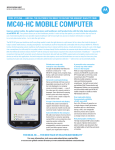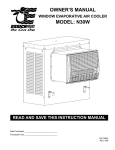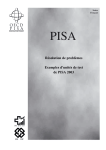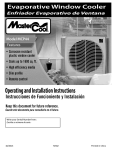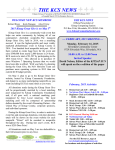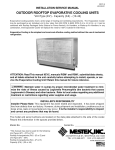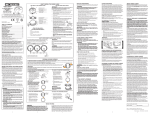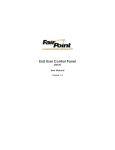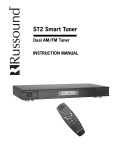Download Tenant`s Manual 572A Union Village Road Draft
Transcript
Tenant’s Manual 572A Union Village Road Draft John H. Harris 2 August 2013 Revision 10, 21 July 2014 Contents 1 Introduction 2 2 Setting Up 2 3 Utilities 3.1 Electricity . . . . . . . 3.1.1 Heating . . . . 3.1.2 Cooling . . . . 3.1.3 Cooking . . . . 3.1.4 Cost Estimate 3.2 Telephone . . . . . . . 3.3 Internet . . . . . . . . 3.4 Recycling and Rubbish 3.5 U.S. Mail . . . . . . . 3.6 Furnishing . . . . . . . 3.7 Transportation . . . . . . . . . . . . . . . . . . . . . . . . . . . . . . . . . . . . . . . . . . . . . . . . . . . . . . . . . . . . . . . . . . . . . . . . . . . . . . . . . . . . . . . . . . . . . . . . . . . . . . . . . . . . . . . . . . . . . . . . . . . . . . . . . . . . . . . . . . . . . . . . . . . . . . . . . . . . . . . . . . . . . . . . . . . . . . . . . . . . 2 2 2 3 3 3 4 4 4 5 5 5 4 Facilities 4.1 The Apartment Space . . . . . . . . . 4.1.1 Fire Safety . . . . . . . . . . . 4.1.2 Switches and Circuit Breakers . 4.1.3 Water and Wastewater . . . . . 4.2 Grounds . . . . . . . . . . . . . . . . . 4.2.1 Yard and Gardens . . . . . . . 4.2.2 Deck . . . . . . . . . . . . . . . 4.2.3 Parking . . . . . . . . . . . . . . . . . . . . . . . . . . . . . . . . . . . . . . . . . . . . . . . . . . . . . . . . . . . . . . . . . . . . . . . . . . . . . . . . . . . . . . . . . . . . . . . . . . . . . . . . . . . . . . . . . . . . . . . . . . . . . . . . . . . . . 6 6 6 6 7 7 7 7 7 . . . . . . . . . . . . . . . . . . . . . . . . . . . . . . . . . . . . . . . . . . . . . . . . . . . . . . . . . . . . . . . . . . . . . . . . . . . . . . . . . . . . . . . . 2 Tenant’s Manual, rev 10 5 House Customs and 5.1 Cleaning . . . . . 5.2 Laundry . . . . . 5.3 Snow Removal . Rules . . . . . . . . . . . . . . . . . . . . . . . . . . . . . . . . . . . . . . . . . . . . . . . . . . . . . . . . . . . . . . . . . . . . . . . . . . . . . . . . . 6 Suppliers and References 7 8 8 9 9 Tenant’s Manual, rev 10 1 3 Introduction This manual is written for renters of the apartment at 572A Union Village Rd, Norwich, VT 05055. It does not supersede the lease—if there is inconsistency between the two documents, the lease takes precedence. There is more useful information at the web site (Section 6). 2 Setting Up The apartment is secured by signing the lease and delivering the damage deposit. You will need an IRS W-9 form, filled out. This is needed to open the escrow savings account, to report the minuscule interest income you will make, so it can be taxed. Once the lease is executed, the renter can proceed with setting up utilities. You should read Section 3 and be sure you will have everything you need. The tenant can move in after the first month’s rent is paid. There are two keys, one for the front door, and one for the basement, needed to access the laundry facilities. If you have any problems or questions, please contact the owner, John Harris, or the property manager, Lis Flannery. There is contact information in Section 6, for us, as well as many suppliers you may want to contact. 3 Utilities In this section we cover expenses not included in the rent. It is in its own section to make it easier for prospective tenants to estimate their overall cost. We have not tired to estimate all the many options with many vendors. The best way to find out is to ask the vendors yourself, so talk directly with the providers about prices, terms, and services. The information in this document is neither comprehensive—there are many other suppliers—nor up-to-date. Some contact information is provided in Section 6. 3.1 Electricity The tenant pays the electric bill for the apartment (excluding water heating, which is included in the rent). You should immediately notify the electric company, Green Mountain Power Company, of the start date and new billing name and address. There is a small charge to initiate service. They will need to know the apartment street address (Section 1). 3.1.1 Heating The apartment has electric baseboard heating. The exterior walls and ceiling are well-insulated and tight, but because of the uninsulated floor, the tenant’s heating costs more sensitive than usual to their temperature preferences. If you Tenant’s Manual, rev 10 4 like a warm room, you will lose some additional heat to my space (at about 66 ◦ F) through the floor. Also note this is effectively zoned heating; you can save significant energy just by only heating the rooms you are using, e.g., only the bedroom at night, or only the big room during the day. The apartment has its own electric meter, on the southwest side of the building; the one labeled “2.” You can read kilowatt-hours (kWh) directly. 3.1.2 Cooling Vermont can get hot, but usually only a couple weeks of the summer. The property is shady, with a high canopy, so it is generally cooler than in town. We are also up, out of the valley heat and humidity. I am planning on adding something for heat mitigation this spring, either an air conditioner, or a wholehouse fan. A whole-house fan (actually a “whole-apartment fan,” in this case) is a fan in the ceiling, that is usually turned on for a short period in the late evening, and draws in air though the windows and cools the entire living and attic spaces. It would be located over the stair well. It might be a good choice in this climate and location. 3.1.3 Cooking The kitchen stove is electric. During the heating season, this is free, because any energy used to cook also warms the room, reducing the energy demand on the baseboard heater. The cost of heating water is included in the rent. 3.1.4 Cost Estimate We don’t have much history, but in the period from August 2013 through January 2014, we had a well-controlled experiment. During that six-month period, the apartment’s total electric consumption was 3231 kWh. This averages to a per-month energy consumption rate of 538.5 kWh/mo) (1837 kBTU/mo, for an average energy cost of 80.60 $/mo, at 0.1496 $/kWh (Nov 2013). The tenant reported: Hi john, sorry the reply took a bit. 1. I keep the apartment about 70 deg 2. I keep the whole place about the same temp 3. I can’t seem to remember to turn the heat down, so it has been at this temp basically all winter. So the numbers above represent a fairly warm room temperature, with essentially no energy conservation measures mentioned in Section 3.1.1. Tenant’s Manual, rev 10 3.2 5 Telephone FairPoint Communication is the local telephone carrier. The apartment is already wired for your line. Comcast, the cable TV company, also offers voice-over-IP (VOIP) service. Cell phone reception at the apartment varies with the provider. So far, the best reception at the apartment (and in Vermont in general), is with Verizon Wireless. In general, cell phone coverage is poor in Vermont and New Hampshire, due primarily to the hills, and lack of development. What we lose in connectivity, we gain in beauty. Reception will improve (at the cost of beauty) as new cell towers are built. Remember to test your cell phone when you visit. Here are a couple helpful strategies: • CDMA cell phones, such as Verizon Wireless and US Cellular, reception in the apartment can be augmented with a network extender, essentially, a household “cell tower” that connects your phone to the cell phone carrier through the internet. If you get internet service (Section 3.3), we can provide the network extender box. You should get very good reception, and there is no monthly fee. • For those living in Vermont or New Hampshire who want a cell phone for their primary number, we recommend getting a service such as a callforwarding service that allows you to have your cell phone number ring to other numbers as well, so you can receive phone calls regardless of your location. Comcast and Google Voice offer such services. 3.3 Internet I use FairPoint Communication (the telephone carrier) for both telephone and DSL. DSL is a digital modem technology transmitted through telephone twisterpair wires, not coaxial cable or optical fiber. FairPoint has good people, but there have been DSL reliability problems, that we hope will be ironed out. The apartment is already wired for its own telephone line, which can carry voice, DSL, or both. Comcast, the cable TV company, also offers internet access. Speeds should be faster than DSL. They offer internet, TV, or VOIP phone. 3.4 Recycling and Rubbish The tenant is responsible for trash removal and recycling. I take my trash and recycling to the Norwich Transfer Station, our recycling center. They have several categories, one humorously called “No sort.” The most common categories are, in the order you encounter them as you drive in: Scrap metal. No pressure vessels, or glass. Tenant’s Manual, rev 10 6 No-sort. Clean paper magazines, newspaper, glass or plastic food containers, cans. No garbage, Styrofoam, plastic bags, or paint cans. Corrugated cardboard. Trash. Universal waste (i.e., nobody wants it), including Styrofoam, but no paint, oil, or chemicals. You must buy coupons at the transfer station; it comes to about $3.00 per big bag. Recycling is restricted to Norwich residents. You must have a sticker on your car; you can get one ($15 per year) at Tracy Hall, downtown. If you recycle and compost (there is a compost pile in our woods), the overall cost can be very low. I have not had curb collection in years. One vendor is Beauchene’s Waste Service. There are others. 3.5 U.S. Mail The shipping address of the apartment is 572A Union Village Rd, Norwich, VT 05055.1 The Norwich post office also has post office boxes. If you choose either, or both, you must fill out a form at the Norwich post office. The mail box is by the driveway entrance on Blood Hill Rd, West, even though the address is on Union Village Rd. Note that Blood Hill Rd has a dead end in the middle. This sometimes confuses visitors and deliveries. Always add the “West” modifier to “Blood Hill Road” when giving directions. 3.6 Furnishing Furnishings are not really a utility, but equipping the apartment to you taste might be a cost, so we include it here. When you are settling in, we will try to work with you on providing furnishings you need, or space for your own furnishings. Let us know your needs when you are negotiating the lease. 3.7 Transportation Transportation is another service that is not really a utility, but is a concern for deciding on renting at a given location. For most, a car is needed to get to the bus stop to park, or to campus, at least in winter. Dartmouth campus. Google says it is about 4 miles (9 minutes) to the Dartmouth square. The Advance Transit Brown Route goes directly to campus. Another good strategy is to drive to the Dartmouth Dewy parking lot, and then ride the Advance Transit shuttle around campus. 1 Note that this is different from the owner’s address, 572 Union Village Rd, which has no ‘A’ after the street number. Tenant’s Manual, rev 10 7 Bus stop. Advance Transit has several stops in Norwich (their Brown Route), and they connect with most other transportation systems. The most used are Tracy Hall, and Dan & Whit’s, across the street. It is 2.4 miles from the apartment. These two stops are visited on approximately 30 minutes intervals. The park & ride stop is slightly closer, and has sanctioned commuter parking, but is only visited twice a day. 4 Facilities 4.1 The Apartment Space Here we cover information about the facilities, and living, in the building. 4.1.1 Fire Safety The fire egress window is in the bedroom, on the southwest side, overlooking the deck and back yard. The fire extinguisher is kept under the kitchen sink. There are smoke and carbon monoxide alarms. The tenant is responsible for • Reading the BRK First Alert User’s Manual. • Replacing the batteries as needed. • Testing the alarms once per week. The alarms run off of the electric service, but each has backup batteries. If either power source fails, they will “chirp” to let you know there is a problem. You should probably keep spare batteries on hand, in case the chirping begins at an inconvenient time. Please use alkaline batteries. If you get a false trip, you can press the button on the alarm to raise the threshold, thus possibly silencing the alarm. Also, open a window to clear the air. If you cannot stop the alarm, call 911 and leave the building. 4.1.2 Switches and Circuit Breakers Wall Switches. You can figure out most of the wall switches by experimentation, but there are a few mysterious ones: • At the entrance door, there are two switches, the front porch light, and one locked on, that controls a circuit in the downstairs living space. • At the bedroom door there are two switches. The one on the left controls a wall receptacle, and is intended for switching a lamp. The other controls the outdoor floodlight on the southwest gable. If the automatic motionsensing light bothers you (it is sometimes tripped by deer), loosen the lock screw, and switch it off. Tenant’s Manual, rev 10 8 • The switch for the kitchen ceiling light is hidden behind the room’s door, near the hinges. The switch inside the room on the southwest wall is for a receptacle found on the northwest wall. Baseboard heaters. There are three baseboard heaters, one in each room. (There is also a ceiling fan heater in the bathroom, for comfort while drying off, but it is not an efficient way to heat.) Each baseboard heater has a thermostat on it controlled with a knob. It is not calibrated—you just have to fiddle with it; we hear this works well. Be careful to leave space all around the heaters for air flow, for efficiency and safety. Circuit breakers. The circuit breaker panel for the apartment is in the hall, to the left of the bathroom door. Do not reset a breaker until you have cleared the cause of the trip. There are ground-fault interrupters (GFIs) on the kitchen and bath receptacles. Each has a light to indicate if it is tripped, and a button to reset it. 4.1.3 Water and Wastewater We have well water. The water is very hard (i.e, contains calcium carbonate, CaCO3 ) as it comes from the well. We have a water softener, which replaces the calcium ions with sodium to make Na2 CO3 (baking soda). Softened water will not form scale or soap scum. The cost of water heating is included in the rent. The wastewater system is a septic tank and leach field. Water use is limited by the septic tank capacity. Please try to conserve water. The water from the sillcock on the southwest side of the house is not softened. 4.2 Grounds 4.2.1 Yard and Gardens 4.2.2 Deck 4.2.3 Parking 5 House Customs and Rules Of course, read your lease—it has a lot of good information. My apologies for the legal gobbledygook; it has been gradually improving, but still has a way to go. This section is intended to cover question about day-to-day living. It excludes much of the obvious, and many things already mentioned in the lease. Much of the content id negotiable—such as the sharing of resources. Tenant’s Manual, rev 10 5.1 9 Cleaning Our biggest concern is to avoid damage to the house from bad cleaning techniques (which are usually ineffective, anyway). When in doubt, please ask. The owner is an engineer and may be able help. The most important point is do not user abrasives on soft surfaces, such as the fiberglass tub insert, or counter tops. 1. For plastic, fiberglass, and wood surfaces: Use “Scrubbing Bubbles,” or equivalent bathroom cleaner to remove soap scum and lime. Use it with a sponge or wash rag. Lime on a soft surface must be removed chemically. Do not use “Soft Scrub”—it is not soft. Its abrasive is the same material as lime, and so it is ineffective in removing lime, but it is harder than plastics, and will scratch them. 2. For porcelain, glass, and chrome plating: Soft Scrub is appropriate. A 3M green scrubby can be used, too. 3. For stainless steel, cast iron: You can use most any abrasive, though there is little need to use anything scratchier than a green scrubby. 5.2 Laundry So far, we have not had a tenant who needed to use the laundry facilities, so the following is somewhat tentative, as we work out the details. The primary considerations are (1) we want to limit the water consumption so we do not overtax the wastewater system, (2) we do not want the cat to escape into the wild. These requirements seem to suggest the following measures: • Please limit your laundry to two loads per week. • Arrange a regular time with the owner, so he can be sure the cat (Pietzi) does not have access to the basement when you are using it. • The water is soft; you do not need much detergent. • To cover energy costs, and as an incentive to do less laundry, we will charge an amount (to be determined) comparable to what one might spend at a laundromat. There will be a coffee tin siting on the dryer for your payment. Here are some procedural considerations: 1. Turn on the water using the dual ball valve. This valve is a safety measure to limit flooding if there is a plumbing failure. 2. Set the washer timer. As the water will begins flowing, be sure it flows into the tub—if the tub is off-center and the flow misses it, or if fabric deflects the flow out, it will end up on the floor. Tenant’s Manual, rev 10 10 3. The water is soft; you do not need much detergent. The tenant will supply the laundry products. 4. When you are done washing, turn off the water using the dual ball valve. 5. When you are done drying, remove the lint from the dryer’s lint screen. 6. There will be a coffee tin siting on the dryer for your payment. If you prefer drying on a cloths line, let us know. 5.3 6 Snow Removal Suppliers and References In this section we give contact information for some of the suppliers you may need to contact for services, and references to other material you may find useful. This is not an exhaustive list. Please let us know if any of this information has changed so we can keep the list up-to-date. Apartment 572A web site: http://UnencumberedDesign.com/572apt/. It has photographs and other useful information. Advance Transit. http://www.advancetransit.com/. The bus system for local transportation. It connects with most other locally accessible transportation systems. Beauchene’s Waste Service, 603–298–7952. One supplier of curbside trash collection. BRK First Alert User’s Manual. http://UnencumberedDesign.com/572apt/ brk-sa710lce.pdf. The manual for the smoke and CO alarms. Comcast. http://www.comcast.com/. Cable TV, internet, and VOIP provider. Dan & Whit’s General Store. 319 Main St, Norwich. (802) 649–1602. A very authentic, well-supplied, and friendly general store. Google Voice. http://google/voice/. A supplier of telephone services that may be helpful in dealing with Vermont and New Hampshire’s spotty cell phone reception. Green Mountain Power Corp. Brattelboro, VT05302. 888–835–4672. The electric power company. John Harris. 572 Union Village Rd, Norwich VT 05055 (owner and neighbor, downstairs). (802) 649–8130. mailto:[email protected]. The property owner and your neighbor, downstairs. FairPoint Communications. 866–984–2001. http://fairpoint.com/ The telephone company. Tenant’s Manual, rev 10 11 Lis Flannery. (802) 649–1906. mailto:[email protected]. Property manager. Norwich Transfer Station. http://norwich.vt.us/transfer-station/. The Town of Norwich’s recycling center. It is about 2 miles away, on the way to campus: Left on Union Village Rd. Go about 2 miles, into Norwich. Right at Turnpike Rd. Go about a mile. Right at New Boston Rd. Right at the Norwich Transfer Station. Bare right. Park anywhere and ask the attendants (wearing orange) to show you around. Smith’s Lawn Service. (802) 649–1094. Our neighbor, Fred, on Blood Hill Rd W, who also also plows the driveway. Town of Norwich. Tracy Hall, 300 Main St, PO box 376, Norwich, VT 05055. (802) 649–1419. Location of the offices of many Norwich departments. U.S. Postal Service. 293 Main St, Norwich, VT 05055. (802) 649–1608. U.S. IRS W-9 Form. http://www.irs.gov/pub/irs-pdf/fw9.pdf. A form needed to declare the income from the deposit escrow account. Verizon Wireless. West Lebanon, NH. 603–298–9900. http://www.verizonwireless. com/. A popular cell phone service provider. They sell the network extender we use: http://www.verizonwireless.com/accessories/samsung-network-extender-scs-2u01/












